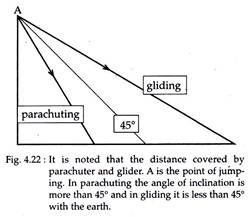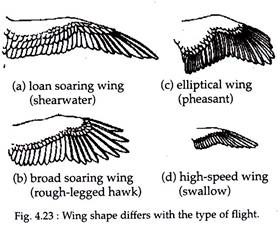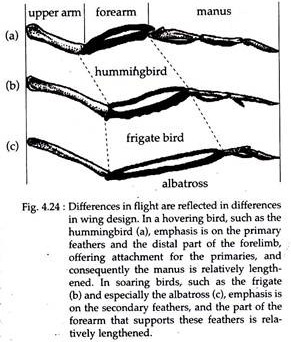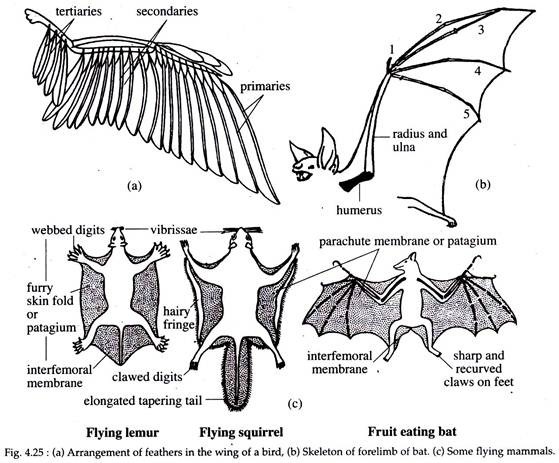In this article we will discuss about the Volant Adaptation in Animals:- 1. Introduction to Volant Adaptation 2. Volant Adaptation in Birds 3. Volant Adaptation in Mammals.
Introduction to Volant Adaptation:
Animal came to the land from water to overcome the competition of space and food in water. Some of them were lured to expedite the air either to escape from enemies or to capture food. But it is interesting that they never succeeded in developing their nest at air. They had to return on earth for resting and nesting.
Therefore, they exhibit dual adaptive modifications — one for air and the other for land. For movement in air they developed flight mechanism in addition to terrestrial or aquatic adaptation. Adaptation of animals in exploring the air or extraterrestrial environment is called volant adaptation.
Characteristics of Volant Atmosphere:
ADVERTISEMENTS:
The environment is characteristically homogeneous and lighter than any other habitable places. There is less possibility of friction with environment during movement. The only problem is the gravitational force of earth.
Pre-requisites for Volant Life:
Development of specialized organs for flying is the primary requirement. Body of a volant animal must be light and rigid. During flight continuous supply of energy and power to the muscles is necessary. Animals are also required to acquire speed adaptation. Moreover, balancing and navigation of the body during flight should be well integrated.
Adaptive Features:
ADVERTISEMENTS:
The volant adapted animals developed flight mechanism as their prime instrument to overcome the attraction force of earth.
There are two types of flight that can be observed in volant animals:
(i) Passive and
(ii) Active Flight.
ADVERTISEMENTS:
i. Passive Flight:
In this type of flight, animals jump from a high point, like hilltop, treetop etc. and come down to earth due to the attraction force of gravity. During their downward journey they cover a horizontal distance with the help of some sustaining organs. In this type of flight the animal never exerts any locomotory force, instead they move passively.
There are two types of passive flight among the animals:
(a) Parachuting and
(b) Gliding.
(a) Parachuting:
The animal during passive flight when comes down on the earth at an angle of 45° or more then it is called parachuting. If we consider the angle with respect to the point of jumping then it can be seen that they are travelling less distance than the gliders (Fig. 4.22).
Example:
Tree frogs.
(b) Gliding:
When the passive flier comes down on the earth at an angle less that 45° then it is called gliding. This type of flier covers more distance than a parachuter if they jump from the same height (Fig. 4.22).
Example: Draco.
Adaptive Modifications for Passive Flier of different Classes:
As the passive fliers are evolved from different groups, so they have modified their respective organs differently.
Modification for Flight in Fishes:
The prime modification is the development of huge pectoral fins – both in structure and in muscular support. Their body becomes highly trimmed. Lower lobe of the hypo-cercal tail fin is large. Before flight, Exocoetus starts swimming just below the water level.
Entire body of the fish comes out of water except the lower lobe of the tail fin. At that moment the pectoral fin becomes fully stretched and the fish leaps out of water and glides. By this way it can cover a distance of 200 – 300 yards.
Modification for Flight in Amphibians:
Tree frogs possess webbed feet. On the lateral side of the body they have fold of skin, known as patagia. During a leap from a higher branch of tree, they stretch their legs and patagia to float in the air.
Modification for Flight in Reptiles:
The flying dragon of Malay (Draco) has patagia extended from thorax up to the bases of the hind limbs and are supported by six pairs of ribs. In flying gecko (Ptychozoon) of Malay the skin is laterally expanded from neck, body, tail, limbs and between toes, which support their body during gliding from a higher place and acting as a float.
In flying snake of Borneo (Chrysopelea) the ventral side of the body is concave. During jumping from a tree to another it keeps its body rigid so that the ribs are extended laterally and act as a parachute.
Modification for Flight in Mammals:
All the flying mammals except bats, possess similar type of modifications as in reptiles for gliding. They have extended patagia from lateral side of the body. During flight the patagia extends and helps the mammal to glide a few distance.
Example of Passive Flying Vertebrates:
Passive fliers are found in all the vertebrate classes except aves. Some of them are listed below.
Class Osteichthyes:
Exocoetus of Indian rivers and seas, Pegasus of Japan, Pantodon of Africa, Dactylopterus (flying garnet) etc.
Class Amphibia:
Hyla, Rhacophorus etc. are commonly known as tree frogs. They belong to the order Anura.
Class Reptilia:
Draco – the flying lizard, Ptychozoon – the flying geko, Chrysopalea – flying snakes etc., all are from order Squamata.
Class Mammalia:
Petaurus (flying opossum), Acrobates (flying phalanger) of order Marsupialia; Galeopithecus (flying lemur or colugo) of order Insectivora; Anomalurus, Hylopetes (flying squirrel) of order Rodentia; Propithecus (Sifaka) of order Primates.
ii. Active Flight:
In active flight the animals actively participate in the flight process. They can start flying from any places they like and land at their favourable places. Generally most birds and some mammals are capable of flying actively. Their adaptation for volant life is discussed below separately.
Volant Adaptation in Birds:
A. External Modifications:
Development of specialized organs for flying is a primary requirement. The body is extremely streamlined and perfectly spindle shaped. At the anterior end is the conical beak and at the posterior end the tail. At the middle portion, the body is smoothly curved without any break. The whole body is covered with different types of feathers.
These are helpful during flight as they minimise friction with air. Fore limb is modified into wings. The wings become efficient tool for flight with the possession of flight feathers or remiges. The remiges born upon hand are- called ‘primaries’, on the arm are called ‘secondaries’ and on the upper arm are called ‘tertiaries’ (Fig. 4.25a).
Besides remiges, several rows of covert feathers close the gaps between the quills of the flight feather and gives the wing a continuous area to beat upon the air. The detail of feathers in birds is given in volume 2 of this book. The feathers of remiges are renewable. Wings are modified according to the need of the type of flight a bird requires for sustenance.
Different type of wings is described below:
i. Elliptical Wing:
This type of wing is for flying at a relatively moderate speed but useful for quick ascent. Aspect ratio (wing span/chord of the wing) is less, about 3 to 6 and found in common birds like sparrow, crow, robin etc. (Fig. 4.23c).
ii. High-speed Wing:
This type of wing can generate much speed. Wings are comparatively small with pointed tips. Aspect ratio is relatively high, in between 5 to 9 and found in swallow, teal, duck, humming bird etc. (Fig. 4.23d).
iii. Loan Soaring Wing:
Wings of this type are very long, narrow and with pointed tip. Lift force of these wings is more than drag, which allows rapid soaring. Aspect ratio is high, between 9 and 18 and found in sea birds like albatross, friget, tern etc. (Fig. 4.23a).
iv. Broad Soaring Wing:
Wings of this type are broad with moderate wing load in comparison to their large body. Aspect ratio is between 6 to 7. Such wings help in slow soaring, take off and descent in a relatively small area. It is seen in eagles, vultures etc. (Fig. 4.23b).
B. Internal Modifications:
i. Modification for Light and Rigid Body:
Light and rigid body construction is achieved through various mechanisms: The bones become pneumatic, which reduces body weight remarkably, Additionally there is a tendency of reduction in number of bones and also fusion of different bones. Cranial bones are thin, paper like and without sutures.
All thoracic vertebrae except the last one are fused to form a single mass the fulcrum. Last thoracic, all lumbars and sacral and a few caudal vertebrae are fused to form syn-sacrum. Last of the caudals are fused to form pygostyle.
Sternum is modified into a boat shaped keel to support the attachment of strong flight muscle. Digits are only three in number. Phalanges in digits are only one or two (Fig. 4.24). The jaws are modified into toothless horny beak. In pigeon, the weight of skeletal system is only 4.4% of the total body weight.
Among many functions of feathers, one is to provide lightness. Air sacs associated with the lungs, reserve hot air that provides lightness. Many internal organs like gall bladder, urinary bladder, right ovary and oviduct are either absent or vestigial and consequently reduces body weight.
ii. Modification for Continuous Supply of Energy and Power:
The food habit of birds and the digesting efficiency is much better than other animals. Absorption is also very efficient because amount of excreta is less. A cedar waxing (Bombycilla) can digest a fruit within 16 minutes.
The heart is comparatively larger in respect to the size of the body and it is very powerful in pumping action. Rate of heartbeat is also higher than other higher animals (average 135 times per minute) at rest. In flying condition maximum heart beat is recorded as 1020 beats/minute in humming bird.
Larger heart and increased rate of beating make blood circulation more efficient for carrying much nutrients and respiratory gases. Amount of blood sugar is almost double than that of mammals (250 mg/100 ml).
Respiration rate is about 30 per minute in average, so more oxygen is allowed to enter the body. Air sacs associated with the lung allow double respiration in single inspiration or inhalation. The body temperature is around 107°-110°F, which reflects the high metabolic rate of birds.
Presence of feathers on the body acts as insulation and do not allow body heat to radiate out. Proper heat conservation allows the birds to fly in the relatively cold and higher altitude.
There are certain arrangements in the body, which reduce the need of muscles. Bone joints in the wings are such that their movements are restricted to one direction only, so muscles for rotation are absent. Arrangement of carpus with humerus is such that with the expansion of elbow, wrist is expanded automatically. This function does not require any muscle, hence energy is gained.
iii. Modification for Speed:
In birds development of bipedality and powerful leg muscles are for attaining speed. In craniates, i.e., flying birds, presence of air sacs reduces friction during flight. The air within the air sacs is also used to cool the body during flight.
iv. Modification of Muscles:
Thoracic muscles perform rapid and powerful beating of wings. These include pectoralis major, pectoralis minor, coracobrachialis etc., which are much developed and comprise about 2/5th of the total body weight. Padding of air sacs between these flight muscles protect them from frictional injury during rapid wing movement.
A highly specialized feature develops in flying birds, called perching mechanism. When the bird sits on the branches of the tree, some leg muscles and tendons act in such a fashion that toes can close round the twig automatically and get locked. To unlock the feet, it is obligatory for the bird to raise its body to straighten the leg and loosening the tendon of the muscles. This feature helps the bird in applying initial thrust and pulling the body for flight.
v. Modification for Balancing and Navigation:
Ideal bilaterally symmetrical body imparts good balance. Centre of gravity is placed between the two wings. All the vital internal heavy organs like, gizzard, liver etc. are situated near the centre of gravity. In the body cavity comparatively lighter organs are placed anteriorly and heavy organs are placed posteriorly. Therefore, they get an advantage of pulling weight rather than pushing. Tail feathers or rectrices are used for navigation.
During flight, balance and navigation are acutely controlled by well-developed sense organs. Bird’s eyes are properly designed for both microscopic and telescopic vision with high resolution and magnification power. Ears are also well developed as night birds can locate pray by accommodating the ears. In some cave dwelling bird, echolocation capability has developed.
Volant Adaptation in Mammals:
Chiropterans (bats) are the only mammalian group, which exhibit true flight. They exhibit various adaptive features for successful volant life. Their adaptive modifications are as follows.
A. External Modifications:
Organ for Flight:
Mainly the fore limbs support extension of skin on either side of the body, known as patagia or alar membrane. This organ functions like the wing of birds. Pollex is free in all bats (Fig. 4.25c). It is clawed and used for climbing. In micro-chiropterans 2nd, 3rd, 4th and 5th digits of fore limb are long and flexible.
In mega- chiropterans 3rd digit of fore limb bears claw. Hind legs are relatively weak and bear five clawed digits. Hind limbs are rotated outward and the knees are directed backward. Therefore, this group can only crawl on the ground with much difficulty.
Well-developed tail serves as support for the inter-femoral membrane and controls movement during flight. In family Vespertilionidae, tip of tail is often free from the inter-femoral membrane and is used as a hook during climbing.
B. Internal Modifications:
i. Modification of Bones:
Metacarpals of 2nd, 3rd, 4th and 5th digits are thin. In micro-chiropterans, a distinct 2nd digit is attached to the 3rd, distally and together supports the anterior margin of the wing (Fig. 2.25b). Fourth and 5th digits are well developed and elongated to support the patagium. Sternum is modified into keel for the attachment of flight muscles. Clavicles are stout and often fused with sternum and scapula.
ii. Modification of Muscles:
Pectoralis major, serratus anterior and subscapularis muscles achieve beating of wings. These muscles are highly developed, powerful and together make 15% of the body weight of bats. Proximal muscles in the arm are heavy and thus, the weight is concentrated near the centre of gravity. Distal muscles are slender and serve to transfer the forces generated by proximal muscles to distal region of arm.
Muscles of the ribs do little movement of the thorax and the respiratory movement is mainly carried out by diaphragm. Tendons of the hind limb provide a very tight catch when the animals are suspended upside- down at rest.
iii. Modification of Tail:
Tail and its enveloping membrane help in changing direction during flight and are used as brake. In some cases it serves as a capacious pouch for holding prey and also as a cradle for the newborn young.
iv. Metabolism:
The metabolic rate is- very high because they require much energy during flight.
v. Modification of Senses:
In these nocturnal animals eyes serve little during night, although eyes are large. Powerful ear in combination with nose and mouth develop a special sensing system, called echolocation. They emit ultrasonic sound from the nose or mouth. These sounds reflect back from the body of prey at night, which are perceived by the ear.



